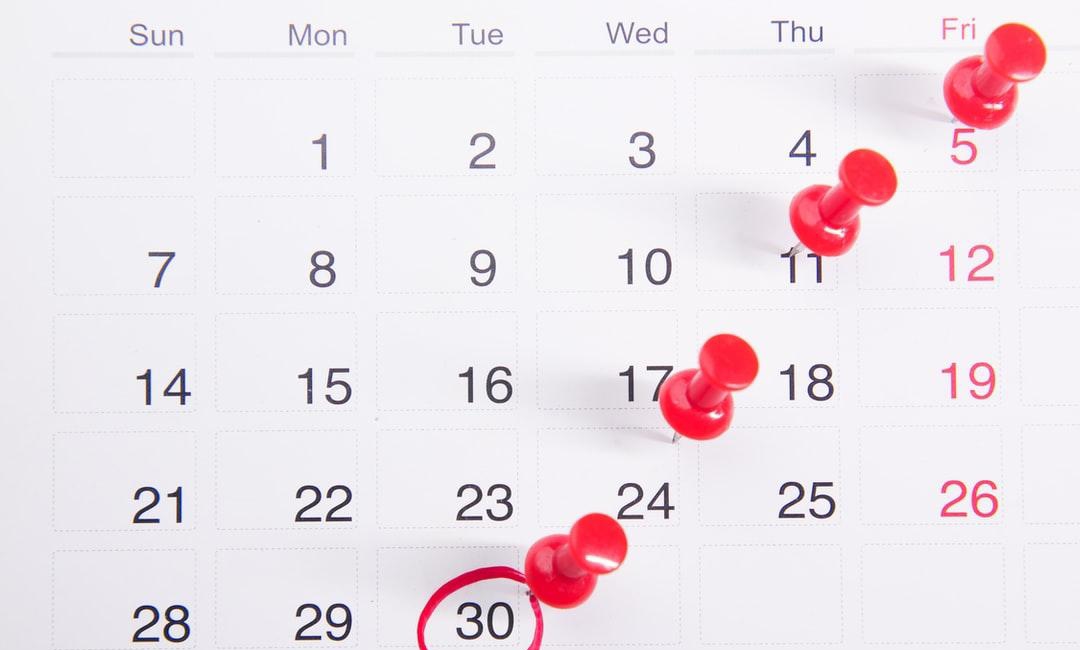While it’s an extremely useful marketing solution for businesses across all industries, social media marketing can be a daunting place for newcomers and veterans alike. And with so many channels to tackle in so little time, it’s vital to stay organized. If you want to brush up on your social media knowledge before creating a calendar, check out The Beginner’s Guide to Social Media.
Successful organizations often piece together a social media calendar to keep track of what they’ll post throughout a specific period of time. Doing so helps them to visualize their content in one place to stay on top of their game. A social media content calendar can be a great tool to help you decide where and when to share what content. Additionally, it allows you to have goals tied to each piece you post.
What is a Social Media Calendar?
When building a social media strategy, staying on top of all upcoming content is a must. That’s where a social media content calendar may come in handy.
We hear you. Putting together and keeping up with a social media calendar sounds like a big commitment at first glance. However, trust us when we say that it will pay off when you invest time to create this useful tool to optimize every social media channel.
In a nutshell, a social media content calendar is an overview of any upcoming social media posts for your brand. Social media calendars can come in all shapes and sizes, from spreadsheets to Google Calendars to customized dashboards you create through a social media management app. The specific calendar template you decide to follow will entirely depend on your particular preferences and goals. The best social media calendar is the one that works for you and evolves with you.
When building a social media calendar, make sure your entries include:
- The exact date and time each social media post is going live
- The platform you’re posting each piece on (Facebook, Twitter, Instagram, etc.)
- The account you’ll be using
- The post’s copy
- The attached creative assets (if any)
- Any links or tags you’re planning to include
- Notes and additional information for your team
As mentioned above, you don’t have to stay married to the same social media calendar template. You can always escalate its scope over time.
5 Reasons You Need a Social Media Calendar
Social media calendars are necessary to create a solid base for your social media routine to run smoothly. Here are the main reasons why incorporating one into your business strategy is an excellent idea.
1. It Helps You Optimize Your Time
Planning has many perks. It allows you to stay focused and have a clearer idea of what your actions will be in a determined period. Of course, building and updating your social media calendar requires time and effort, but not as much as pulling posts out of your sleeve at random times could.
Ultimately, using a simple organization tool will help you avoid working double, which will free your time for other important tasks.
With your regular operation out of the way, you’ll also have more time for posting about sudden news and events. In addition, you’ll have more time to think about posts that are relevant to your audience and will increase engagement.
2. It Allows You to Post More Consistently and Ambitiously
In social media, consistency is everything. Otherwise, it’s a lot harder to build and maintain a loyal following. Your audience expects to see content from you with a certain frequency, and posting willy-nilly just won’t do it for them in most cases. You need to show up for your followers.
If you’re looking to increase engagement and organic reach across your Instagram, YouTube, Facebook, and Twitter – or any other social media networks, for that matter – social media management will get you there faster. The consistency you can achieve by crafting a social media master plan can also help you crack the algorithm to get in front of the right eyes.
Having a social media calendar is also an excellent way to stay on the right track when running multiple campaigns across numerous channels. Knowing your schedule is the easiest way to ensure every piece gets posted in time exactly where it should. Additionally, planning lets you look at the bigger picture and incorporate more ambitious actions into your strategy.
3. It Gives You More Time for Spellcheck and Quality Control
When you randomly post content on your social media accounts you’re more prone to make mistakes. Planning allows you to double-check your copy and correct it if necessary before it reaches your audience. Copy-editing and fact-checking are excellent ways to keep your posts’ quality up. This will generate a lot more credibility among your followers and make you look more professional.
Nowadays, it’s common for social media posts to have a full creative team behind them. Planning your content on a social media calendar lets all parties involved to be on the same page to ensure all posts are spot on. Moreover, it gives you time to run all content across the board to guarantee nothing even slightly off-brand sees the light.
4. It Ensures No Post Slips Your Mind
Having a visual overview of what you want to post is a bulletproof way to ensure that you actually publish them. It reduces the risks of you or your team forgetting about important content and posting it with perfect timing. That way, no copy goes to waste.
5. It’s an Opportunity to Track How Your Posts Are Doing
Social media marketing can often be a matter of trial and error before you get it right. Having a social media calendar allows you to expedite the “trial” part to detect errors much faster and act on them. It lets you schedule your A/B test and, in turn, helps you figure out the best posting formula for your content. This way you can understand what’s working so that you can replicate it, and what’s not so that you can take action into fixing it for your audience.

5 Steps to Creating a Social Media Calendar
Creating an effective social media calendar that will meet your specific needs doesn’t happen overnight. You need to follow certain steps to ensure your template checks all the boxes. When you’re new to the whole concept of making a calendar for social media, having your goals clear is a must. That’s why you might want to master your social media marketing strategy first. Once you have clearly understood what you want to accomplish, you can proceed to create your social media calendar, following these steps.
1. Have a Look at Your Current Social Media Strategy and Content
Auditing what you’re currently posting on social media and your previous efforts will give you a much clearer picture of what’s working so far and what you need to improve. This will allow you to develop a more efficient strategy to boost your return on investment.
Make sure to go through all of your assets so that you can better determine what gets the most engagement. Other elements to consider while auditing include:
- Impostor accounts among your followers
- Ghosts or outdated accounts that no longer interact with your posts
- Weak passwords
- Account security vulnerabilities
- Short and long-term goals
- KPIs per branded account by platform
- Your user persona
- Who in your team is responsible for certain tasks
- Successful posts and campaigns
- Result-yielding tactics
- Gaps and underwhelming results
- Areas of improvement
- Metrics for future success by platform
Once you’ve examined how you’ve conducted your social media efforts, you can create a refreshed strategy that will resonate with your audience. Make special emphasis to understand your weaknesses so that you’re able to turn them into strengths once you set up your calendar.
2. Select Your Preferred Social Media Platforms to Communicate With Your Audience
Just because a social media platform exists, it doesn’t mean you need to incorporate it into your strategy. You need to understand where your audience is and tackle those channels for more efficient communication. Learn more about each network’s demographics and determine if putting efforts into creating content for them is worth it to reach your goals.
Once you’ve decided where you’ll be posting, you’ll have a clearer idea of how much content you’ll need to generate. Additionally, you’ll be able to begin planning the best times to post on each social media site.
3. Determine the Data You’ll Need to Include in your Calendar
No two social media calendars are built the same way. That’s because each business has different content creation and posting needs to attract and maintain their audience. Decide what your social media calendar is going to look like and start mapping out the information you’ll need to include.
The more accounts you manage, the more complex your calendar will need to be. Some of the details you might need to incorporate into your social media calendar are:
- Date
- Time
- Time zone
- Copy
- Visual assets
- Links
- Tags
- Platform
- Format
- Campaign
- Target
- Value
You can even include additional notes that will help anyone involved to understand if a post is paid or organic, its budgeting details if it’s been approved, and if it’s already been posted. On top of that, adding analytics is an excellent way to keep track of the performance of your posts for future audits.
4. Establish a Clear Workflow
To start drafting your social media calendar, you need to determine if you’ll be working on a daily, weekly, or monthly basis. Then you can start thinking about factors like:
- How often you’ll post
- The best times to reach your audience
- How much content you’ll post on each platform
- Who’s approving the content you’re posting
- The creative process behind each post
- The production process
This information will let you outline your workflow. Make a copy of it and share it with your social media team. This way, everyone will be in sync regarding definitions and processes. Creating an additional tab in your social media calendar spreadsheet is a great way to ensure this data is available for all other parties involved.
5. Produce and Publish Your Posts
Taking care of the steps above will probably get the ideas flowing. Use that creative momentum to come up with content to add to your social media calendar. The more posts, the merrier. You can always distribute them throughout a certain period. You can add columns, notes, color codes, images, etc.
Brainstorm with your team and evaluate your calendar as you go. The goal is for the final document to be clear for everyone involved. Be sure to include all the details and organize your data in a way that everyone can understand it.
When in doubt, don’t be afraid to ask for feedback from your colleagues, especially those who will use the calendar every day. Check for gaps and make sure that:
- Everyone has the password
- All team members understand the parameters
- Everybody knows how to represent your brand identity and voice in the posts
- Everyone has access to the necessary assets
Once all that’s taken care of, you can proceed to schedule your posts. Remember to publish consistently and, if needed, use an automation tool to handle your feeds.
Pro Tip: Create an Asset Content Library
Having a digital social media database will save you tons of time when you need specific visual content to enhance your posts. Use your favorite cloud storage service to keep copies of pictures, memes, infographics, and any other content that may come in handy at some point. This will spare you the need to spend hours on end looking for the perfect image you swear you saw somewhere online.
Examples of Social Media Calendars
As you probably already realized, a social media calendar is much more than a way to source your Facebook business page. It’s an essential social media marketing tool that allows your social media team to have a clearer overview of your social media strategy and understand what needs to be done and when. Many companies turn to this social media staple to make their lives much easier.
There are many types of social media calendars. The most common are:
- Social media content calendar – This includes all of your social media posts along with the copy, images, links, and resources you’ll use.
- Social media task management calendar – This focuses on the roles each team member plays in the successful production, scheduling, and publishing of your posts.
- Social media strategy calendar – This gives more importance to the tactical elements in your social media plan.
- Social media editorial calendar – This can help you plan when and which content will be shared, manage your campaigns, track all deadlines, and add potential advertisers into the mix.
Free Social Media Calendar Template
Having a social media calendar is a no-brainer in your business plan. Don’t be afraid if you don’t perfect it on the first try. You can always go back and make some adjustments if you feel something isn’t working the way you expected. If you still don’t know where to begin, this simple social media scheduling spreadsheet will get you going.
Platform
Author
Copy
Deadline
Publishing Time
Publishing Date
Notes
As your social media needs evolve, you can start adding tabs to include new platforms or organize your calendar by day, week, or month. Using colors to identify certain components in your calendar is also an excellent idea.
Social Media Calendar Tools
Creating a social media calendar is simple if you have the right tools. Some of them might be right under your nose and you probably haven’t noticed. If you want to get started with your social media scheduling as soon as possible, here are the most popular planning alternatives you can arm yourself with.
Google Sheets
This cloud spreadsheet giant provides you with a simple yet effective way to stay organized and keep all your social media planning data in one place. You can use it to create a spreadsheet and make it as simple or complex as you want. Google Sheets allows you to color-code your database, incorporate links and images, add tabs, and get as creative as you want.
Google Calendars
If you don’t feel like creating a spreadsheet, you can use an actual calendar to schedule your social media posts as if they were events. Of course, this app is more limited in options than say a task manager app or a spreadsheet creating program, but it’ll do if all you need is a reminder of when to post what. This might be a more viable option for those who only manage a small social media account.
Scorpion
If you need to work with more than one account across multiple social channels, purchasing a more complex solution might be your best bet. Professional marketing services like Scorpion help users like you effectively deal with all of your social media needs, including post scheduling.
Final Take
Your social media calendar is the first step to success on Facebook, Instagram, Twitter, and all of the other social channels available today. It should be a part of your overall content calendar as well so that you can use social channels to promote those great blog posts and podcasts you are creating. If you need some help getting started, connect with us at Scorpion. We have the know-how and technology to help you find success with your social media scheduling.
Need help?
Scorpion has a great social platform to bring all of your social channels into one place. Best of all, we have have the team to help you set everything up and manage your social media marketing so you can run your best business. Get started with Scorpion.



